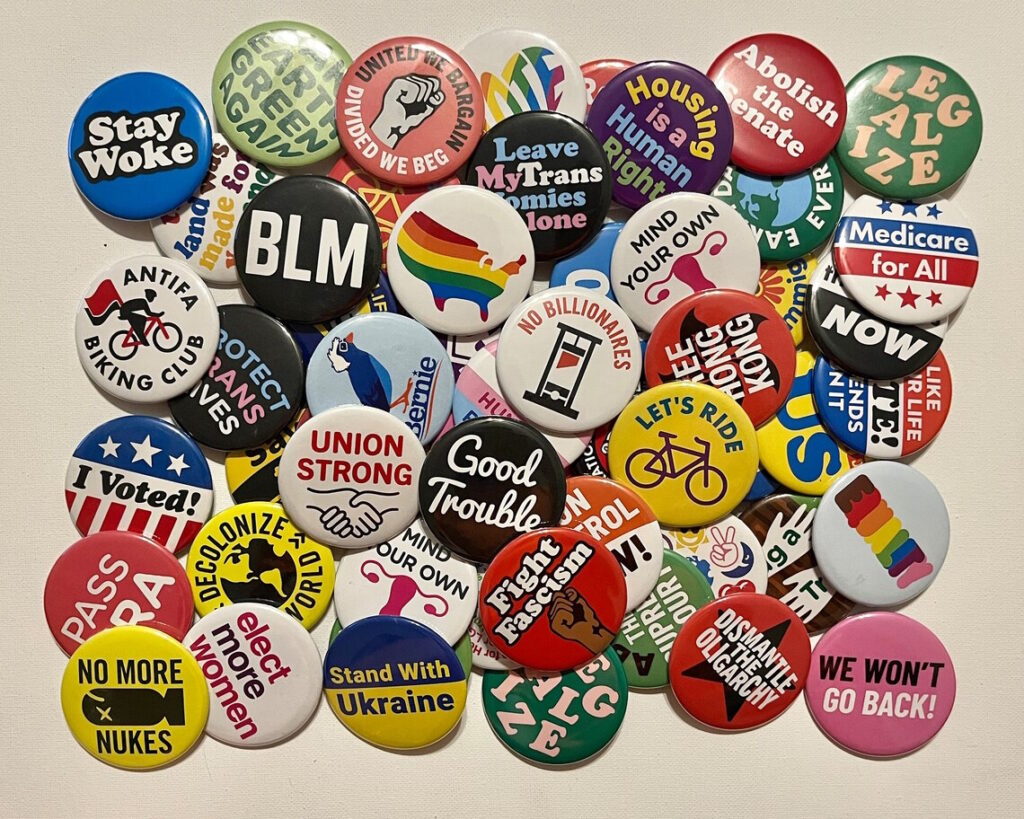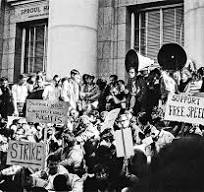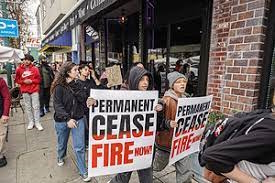A Perspective And Primer For Students, Parents and School Professionals As 6oth Anniversary Of Free Speech Movement At Cal Approaches.
(Note: this article is part of ANN’s educational mission consistent with our 501C-3, non-profit standing; this article is for informational purposes, and does not constitute legal advice )

By Larry Freeman
Today, as our local schools generally enrich and empower student expression – often bringing a variety of tones and social or political agendas—we largely take for granted that students –who often have something to say about school , society , politics and so on — ought to be able to speak out.
To a point, that is, and therein lies the rub.
In Alameda’s Public Schools, this article’s focus with another to follow on The Private school sector) student freedom of speech from those still maturing is deeply integral to school climate and purpose.
Encinal High School, for example, hosts a number of student-centric clubs that lend voice and belonging that offer various, sometimes agenda driven viewpoints as part of student free expression.
Take, for example, the school’s clubs that support and celebrate various demographics as La Isla, The Filipino Club, The Chinese Club, The Black Student Union and The GSA (Gender and Sexuality Association).
Alameda High sports its own variety of Clubs that promote cultural diversity and acceptance, elements that are not always tolerated, encouraged or even legal in some other states or communities.
Among its many clubs, it offers All Things Korean, The Afghan Student Union, Asian American Activists, Asian Cultural Unity, The Black Student Union, Chinese Culture Club, a GSA, The Jewish Student Union, Latinx Unidos, The Mixed Student Union, The Oasis Club — a Christian Gospel based group—a Sierra Club, A Filipino Club, The Vietnamese Student Association, The Women’s Justice Club and fittingly for this story, The Youth Voice Club.
While these organs of student expression are generally seen as a desired and positive given, the notion of public school students engaging in socio-political speech on campus,– especially when it challenged established the orthodoxy of the late 1950’s and early 1960’s, was an anathema in The United States.
The medieval adage that ”children should be seen and not heard,” was the coin of the realm at the time, whether in homes or under the ‘loco parentis’ role of schools.
Never mind that confounding, double-edged sword of free speech known as the First Amendment.
Not for you kids, unless you are asked to speak and we approve of what you say.
TODAY, RIGHT HERE IN ALAMEDA, STUDENT FREE EXPRESSION RIGHTS ARE ALIVE AND WELL
Little did folks in California know, that a U.C. Berkeley based student political group. SLATE, protesting JFK’s Cuban Missile Crisis policies in 1962, would help change all that.
Today, right here in Alameda and all over the state, the group’s impact on broadening free speech rights, pioneered student expression rights on campus.
Alameda public school students, –as well as those all over California –now enjoy, often in highly misunderstood or under-asserted ways– a broad range of free speech rights at school.
The year 2024 marks the 60th anniversary of the renowned Free Speech Movement at Cal, but SLATE’s political activism in 1962 fed the fire for the “silent generation” to start to get loud and gave voice to those who could study and write essays on politics, but not express their views in the quad if the school authorities did not approve.
Today, Alameda public schools, including The College Of Alameda, offer a variety of student centered or student led clubs, classes, a smattering of publications and media classes and other programs whose expressions and messaging the schools no longer can control in ways they used to, — or in some cases, might still want to.
So for students, parents, teachers and everyone else in the community, here is a brief look at what students in public and private schools in Alameda can and can’t say, write, symbolize and so on when under school jurisdiction.
FSM’S LASTING LEGACY: A ROBUST, CALIFORNIA STUDENT FREE EXPRESSION LAW

Thanks in part to the FSM, and an overall embrace for student free speech by California’s Legislature, Public and Charter school students in California, including those termed “magnet schools, “ “academies” “institutes” and so on, have broad speech and press protections under California Education Code 48907.
The heart of the law protecting student free expression is found in these two segments:
” a) Pupils of the public schools, including charter schools, shall have the right to exercise freedom of speech and of the press including, but not limited to, the use of bulletin boards, the distribution of printed materials or petitions, the wearing of buttons, badges, and other insignia, and the right of expression in official publications, whether or not the publications or other means of expression are supported financially by the school or by use of school facilities,…
(c) Pupil editors of official school publications shall be responsible for assigning and editing the news, editorial, and feature content of their publications subject to the limitations of this section….”
In short, like it or not, when it comes to matters of on campus, public school expression of political, social or religious views, students have virtually the same rights as they do off campus, provided that expression does not violate limited, though highly specific restrictions, as indicated below.
Beyond its broad scope of lawful expression, 48907 provides substantial aspects related to various means of expression as well as places for it.
The following liberty loving sections pronounces that student expression includes, but is not limited to, “the use of bulletin boards, the distribution of printed materials or petitions, the wearing of buttons, badges, and other insignia, and the right of expression in official publications, whether or not the publications or other means of expression are supported financially by the school or by use of school facilities.”
In short, schools must provide at least a minimal, open spot and amount of space for students, without school permission, to place or post their messages, even personal ones.
Schools can reserve exclusive spots for information posting as a library showcase or spot for athletic or club announcments, but there must be a place for any student to post a personally created message, within the broad scope of allowed expressiion.
It also means that kids can circulate petitions calling for change in administration policies or other changes in school operation, mission, local or national issues and so forth.
When it comes to expression in”official” school publications as yearbooks, school newspapers, or types of online expression originating at school, kids also have wide latitude and the upper hand in determining what content is to be published.
As such, school administrations and faculty have to permit and give latitude for student speech , even when it goes against their standards of taste, political leanings, concerns about the image or reputation of the school in the public eye, or of offending the sensibilities of local government or the community,
STUDENT SPEECH THAT IS OFF LIMITS
Those in authority at a California public school can lawfully prohibit speech only on very few, but generally well defined grounds.
For starters, if the student speech etc. does not pose what courts have determined is “obscene, libelous or slanderous, ” the public school cannot censor or punish it.
Broadly defined, “libelous and slanderous “apply to statements asserted as fact that are untrue and cause provable harm, including reputational injury, to an individual or entity are not protected.
In the case of a school setting, this includes the harm that could expose a person, student, teacher, administrator etc. to hatred, contempt or ridicule.
Falsely calling a campus affiliated person a “a friend of genocide ” or “a thief who stole ballots from the student body election and rigged it by having past students vote”, “a coach who misappropriates athletic funds” and other such derogatory statements would not be protected speech in either a public or private school.
If however, such statements were truthful and established by fact, they would be permissible.
Ed Code 48907 also prohibits speech etc. that causes or is highly likely to cause, “substantial and material (actual, visible) disruption of the orderly operation of the school,”
A student led call for a “walkout,” “sickout” or “ protest march to shut down classes ” or creating and fanning the flames of a “boo bird brigade at a rally or game” during school hours or at a school function would almost certainly be unlawful.

The duration and impact of what rises, under case law, to the level of “substantial” is another gray area, but that means it has to be something pretty big.
Ten kids chanting in the hallway for thirty seconds would probably not rise to that level, though teachers or administration would have the power to require that it end to prevent a longer and more disruptive impact.
Also not protected are statements that unlawfully deny or intrude upon various individual student and adult rights on campus or in extensions of school expression, including off campus school events that operate under the authority of the school (field trips, athletic competitions etc.).These protections involve three main categories:
(1) The right to be secure in person and in property and free from threats to health and safety.
(2) The right to be free from coercion, in other words the right to be left alone. This aspect is often thought of in terms of “harassment” or “bullying,” forms of expression that are not protected.
(3) The right of respect for the dignity of the individual and the expression of his/her views and opinions, provided those views or opinions are not unlawful under 48907 in and of themselves.
Then there is the type of content that is often been a perennial matter of great fascination to youngsters: rude, smutty, suggestive sexual innuendo, body type and appearance put downs or slurs, references to the post-digestive or excretory processes etc.
Start with ‘cussing’ or other ‘vulgar’ forms of expression.
Maybe the words of choice, gesture or drawing are not legally obscene; consider the usual lexicon of swear words and images.
Still, if such terminology etc.might not have, according to the courts, “redeeming social value or importance to minors,” it could be lawfully suppressed.
“Awwww shhhhhucks, mom. “
If the speech is overtly sexual, racist, discriminatory against various gender, gender identity, ethnicity, –including ethnic origin or immigration status– sexual orientation, or advocates the use unlawful substances as drugs, alcohol and tobacco and so on, it is not protected.
Threats (statements etc.) of doing physical violence or other physical harm to another are also unlawful, for obvious reasons.
However, statements of opinion – -“an oppressive, clueless, unenlightened school administration; this place is a pit and a prison!” or “the cafeteria serves overpriced slop not fit for a wild boar!” or “I hate school and our stupid, irrelevant, graduation requirements” — even though the content may be in bad in taste, in bad form and insulting to the school, and school officials– would likely be protected by a court.
When it comes to denigrating or insulting a teacher, things get a bit more complex. Generally, even if the words are opinions that are brash, biting and hurtful to a teacher, sully the teacher’s competence, fairness, wherewithal and so on, and as long as they don’t violate the key limits above, the student will likely be protected under the law.
Kids hold and express often fierce opinions on teachers, maybe love, maybe hate. For the latter we can consider such as, “Mr. Feenamindt is a bogus hoax of a teacher who is mean, totally unfair, runs class like a dictator and is a rat’s butt. He sucks and I hate him.”
The pivot is that since public school teachers are government employees, even such addle-headed, derisive words as those are considered political language, and have to be permitted by the school.
So all those visceral and even vengeful things kids say or scrawl in notebooks. and now post in cyberspace, as though on a mobile billboard, are generally not legally subject to disciplinary action.
That said, any school culture and site leadership should not just let that stuff pass by. Conversations, parent contact and the like are in order for that kind of student expression.
But why stoop to badmouthing, as a matter of ethics and taste? Courtesy and respect need not only be a matter of law.
WHEN IT COMES TO SCHOOL PAPERS AND YEARBOOKS, KIDS ARE AT THE HELM.
Part (c) of 48907 actually gives student editors of publications near complete authority to assign and approve or disapprove of their content.
Advisors (faculty) can only prohibit content that is unlawful or that falls within the subjective and gray area of their responsibility “to maintain professional standards of English and journalism.”
Notably these provisions, as with the rest of 48907, apply to State Universities, Colleges, Community Colleges and all other publicly funded institutions of higher learning.
Yes, the students and grad students of the vaunted University Of California Berkeley, home of the Free Speech Movement of 1964, actually have far more rights than did their predecessors sixty years ago.
And so do students at The College of Alameda, or at Alameda Academy, for that matter.
But the spirit and reach of the law goes only so far.
When push comes to shove, for a student or student entity to stand up for the right, resolve, resources and action has to follow if expression rights have been impinged upon.
.
The key is, if the school moves to suppress or prevent the speech (‘take down that negative campaign poster! ”) it will be up to the student, or affected school based, ‘injured’ party to take the matter to court.
And that will require adult assistance, unless the student is over eighteen.
If such a court challenge actually happens, (very very rare, in reality) then the school will have the burden of proof to show in court that they had legal grounds to suppress it.
And, as we all know, the wheels of justice move slowly, and time in not on the student’s side when it comes to the immediacy of any court ordered remedy.
SOME PERSPECTIVE AND A BRIEF COMMENTARY
To be sure, freedom of speech is a double edged sword that poses the great power of shedding the light of truth into the dark reaches of wrongdoings and peril to expose it to the public view, as a check and balance.
But it also leaves wide open the door for malicious, discriminatory, seditious, corrupt and may types of false and disingenuous speech from those who seek to exploit free speech for their own malign purposes.
So, when it comes to setting passionate youngsters loose with an armory of words and ideas they want conveyed, the sword cuts both ways.
As such, education about the power of free speech to benefit the public good and not contribute to the public bad is a key.
On the other hand, censorship of student speech outside of the legitimate and necessary boundaries provided under California law, runs counter to the central tenet of American values and our Constitution.
The key is for students, teachers, administrators and parents to know what kids’ rights are an to protect them when students are in the right, and reorient and inform them when they are in the wrong.
If only it were so in the adult world of today.
===============================
